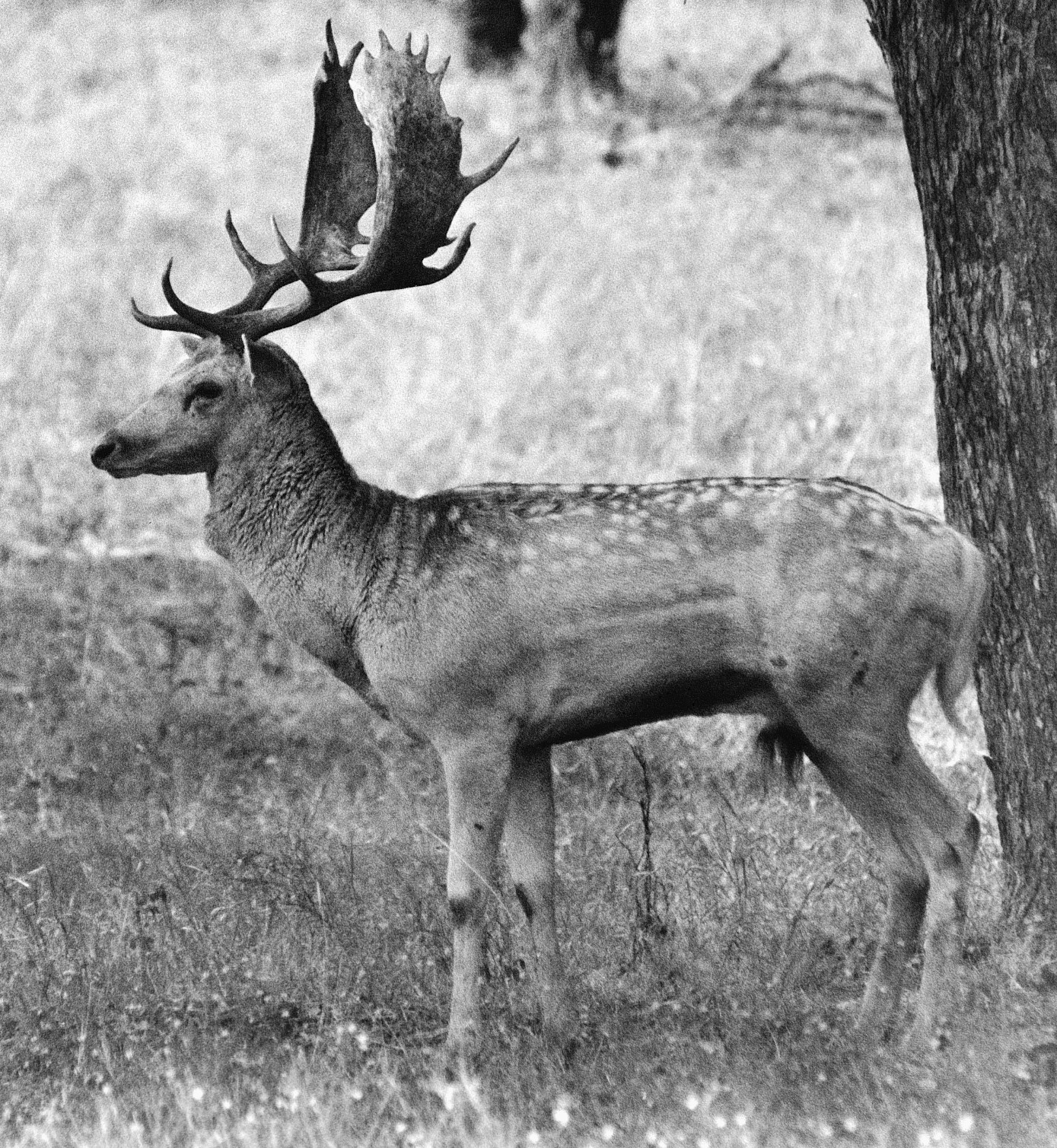FALLOW DEER*
Dama dama (Linnaeus 1758)
Order Artiodactyla : Family Cervidae
*Introduced species
DESCRIPTION. A medium-sized, rangy deer; adult males with large palmate antlers. Bucks develop spike antlers beginning in their first year and, until 3–4 years old, grow and cast antlers composed of only beams and simple points. At 3–4 years of age, males may develop antlers with broad, palmate areas that measure 8–25 cm in width; total length of antlers is up to 39 cm. Coloration is highly variable, but four color forms predominate: common—rust color with white rump patch and belly, white spots on back and sides merging into a white line along the lower side and near the rump on the haunches; a black line runs down the back and often connects with the black upper surface of the tail; in winter, spots become indistinct; menil—contrasts with common color form in that ground coloration is tan rather than rust and dorsal lines are brown rather than black; white spotting remains distinct in winter coat; white—coloration is white, with dark eyes; not true albinism; and black—very dark but not truly black; spotting barely visible; in winter appears as dull brown. In Texas, black, white, and menil color forms predominate. Fallow deer stand 91–97 cm at the shoulder and appear thin. Males weigh 79–102 kg but may lose 9–23 kg during rut. Females weigh 36–41 kg.

DISTRIBUTION. Native to the Mediterranean region of Europe and Asia Minor, fallow deer are the most widely kept of the world's deer and have been introduced to all inhabited continents. Texas now has over 10,000 individuals, about one-third outside confinement, mostly on the Edwards Plateau and adjacent areas.
HABITS. Fallow deer do much of their feeding in open, grassy areas but require tree cover and undergrowth for shelter and winter food. Deciduous or mixed woodlands on gently rolling terrain are best, but conifer forests may be suitable in some places. The Edwards Plateau region, with its mosaic of oak mottes, juniper brushland, and grassy areas, is well suited for fallow deer.
Food availability appears to determine whether fallow deer in an area are predominantly grazers or browsers. On the Kerr Wildlife Management Area (Kerr County), fallow deer ate 54% browse, 30% grass, 12% forbs, and 5% other, although those figures varied as the degree of competition with domestic livestock and white-tailed deer varied. Live oak, shin oak, hackberry, and Spanish oak were the dominant browse species taken; Texas wintergrass, fall witchgrass, and common curly mesquite were the predominant grasses eaten. Increased competition for browse with white-tailed deer caused fallow deer to increase their dependence on grasses, and increased livestock competition for grasses led fallow deer to increase their use of browse.
Rutting may begin in mid-September and continue into November, but peak breeding activity takes place in October. During rut, bucks mark off and defend a small area, known as a stand, from which other rutting males are excluded; females and young remain within the male territories, and as each doe comes into heat, she is followed until mating is accomplished. After the rut, males gradually cease defending their territories and form bachelor groups, whereas females and young remain segregated from males in their own groups.
The gestation period is approximately 7.5 months, with most fawning occurring from late May through June. Generally, only a single fawn is born, although twins are not uncommon. Females reach sexual maturity at 16 months and can bear their first fawn by 2 years of age. Bucks mature sexually at 14 months but rarely compete successfully in rutting until several years later. Bucks attain physical maturity at 6 years of age. Life span is about 11–15 years, with a maximum record of 25 years.
POPULATION STATUS. Introduced, common. The exotic fallow deer is mostly found on managed high-fence ranches throughout the Hill Country.
CONSERVATION STATUS. The IUCN lists the fallow deer as a species of least concern. It does not appear on any federal or state lists of concerned species. Its effect on the native fauna and flora has not been accurately determined but should be monitored so that action can be taken, as necessary, to protect our native wildlife, such as white-tailed deer.
From The Mammals of Texas, Seventh Edition by David J. Schmidly and Robert D. Bradley, copyright © 1994, 2004, 2016. Courtesy of the University of Texas Press.
Natural Science Research Laboratory
-
Address
Museum of Texas Tech University, 3301 4th street, Lubbock, TX 79409 -
Phone
806.742.2486 -
Email
nsrl.museum@ttu.edu

